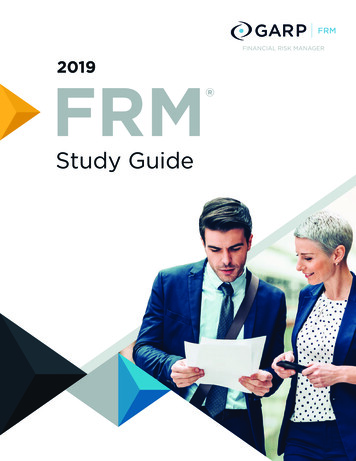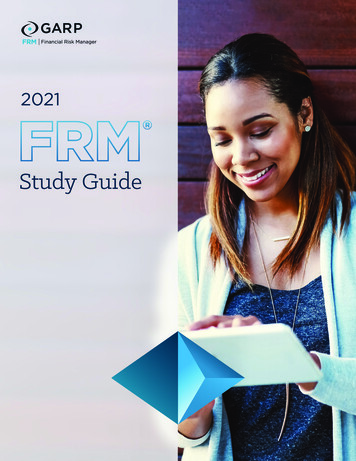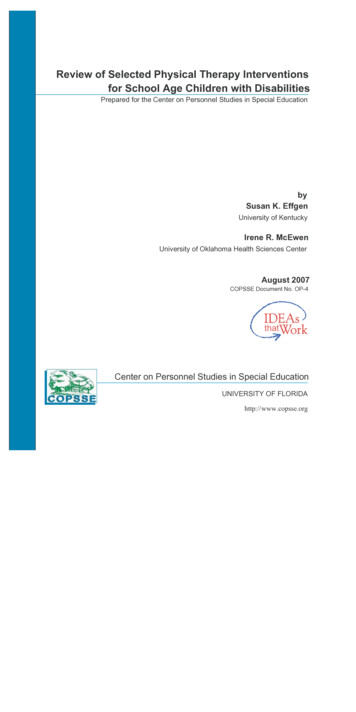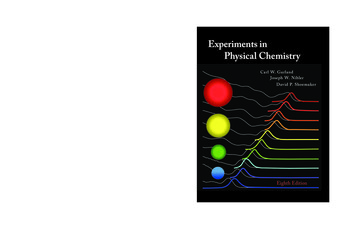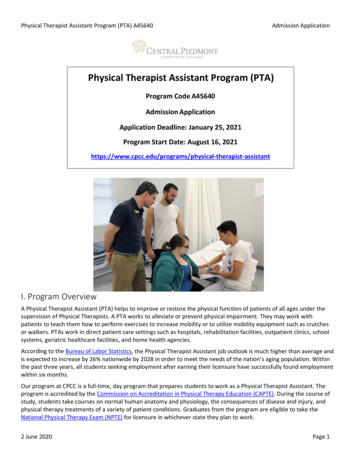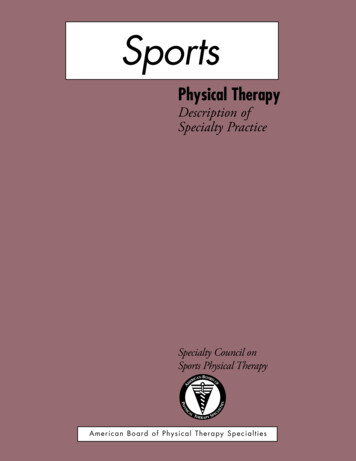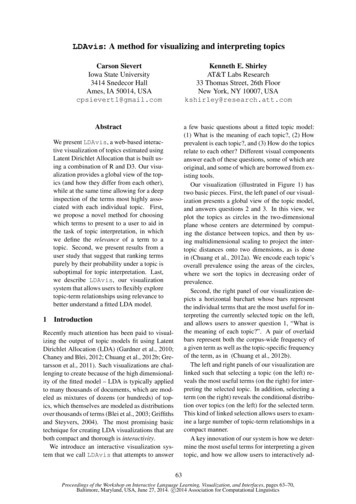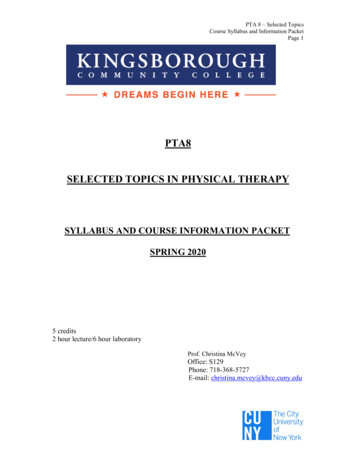
Transcription
PTA 8 – Selected TopicsCourse Syllabus and Information PacketPage 1PTA8SELECTED TOPICS IN PHYSICAL THERAPYSYLLABUS AND COURSE INFORMATION PACKETSPRING 20205 credits2 hour lecture/6 hour laboratoryProf. Christina McVeyOffice: S129Phone: 718-368-5727E-mail: christina.mcvey@kbcc.cuny.edu
PTA 8 – Selected TopicsCourse Syllabus and Information PacketPage 2KINGSBOROUGH COMMUNITY COLLEGEOF THECITY UNIVERSITY OF NEW YORKPhysical Therapist Assistant ProgramCourse SyllabusPTA 8SELECTED TOPICS IN PHYSICAL THERAPYCourse Description: This course presents selected topics related to the physical therapymanagement of pathology. These topics include normal motordevelopment, neuro-development techniques, proprioceptiveneuromuscular facilitation, back pathologies and interventions,orthotic management, amputee and prosthetic management, basicconcepts in pharmacology and administrative topics. Additionally,this course reviews and presents ethical and legal issues includingsexual harassment and misconduct, and multicultural sensitivity.Application of all previously learned material in the classroom,laboratory and clinical setting is also facilitated.Pre-requisites: PTA1, PTA 2, PTA3, PTA 10, PTA 20, PTA 4, PTA 5, PTA 6BIO 11, BIO 12Co-requisites: PTA 7, PTA 25Textbook Requirements: Kisner, C., Colby, L. (2018). Therapeutic ExerciseFoundations and Techniques seventh edition. Phil., PA:F.A. Davis Company.Barrett, Christina (2021) Dreeben-Irimia’s Introduction toPhysical Therapy Practice for Physical Therapist Assistant.Fourth Ed. Sudbury, MA: Jones and Bartlett Publishers.Skinner, S., McVey, C. (2012). Pocket notes for the physicaltherapist assistant 2nd edition. Sudbury, MA: Jones andBartlett Publishers.Skinner, S., McVey, C (2011). Clinical Decision Making forthe Physical Therapist Assistant. Sudbury, MA: Jones andBartlett Publishers.
PTA 8 – Selected TopicsCourse Syllabus and Information PacketPage 3Student Learning ObjectivesAs evidenced by successful performance and completion of written and practicalexaminations, assignments, oral presentations and participation in and analysis ofclinical scenarios, the student will:1.0 Implement basic neuromuscular and developmental intervention for mockadults and pediatric cases as prescribed by physical therapists.1.1. Identify and explain normal motor development.1.2. Identify the determinants and development of balance and equilibrium.1.3. Distinguish balance and righting reactions and their effects on normal andpathological motor development.1.4. Identify pathological effects on normal motor development including synergisticpatterns and tonal changes.1.5. Identify and describe basic neuro-developmental techniques and basicproprioceptive neuromuscular facilitation techniques.1.6. Demonstrate and instruct basic neuro-developmental techniques using properhand placement and positioning.1.7. Demonstrate and instruct basic proprioceptive neuromuscular facilitationtechniques using primary and secondary patterns.1.8. Perform neuro-developmental mat activities.1.9. Perform basic neuro-developmental and proprioceptive neuromuscularfacilitation techniques.1.10. Perform balance and coordination activities.2.0 Implement intervention for cervical and lumbar dysfunction as prescribed byphysical therapists.2.1. Recall and distinguish bony and soft tissue structures of the neck and back.2.2. Identify and describe approaches to the management of neck and low back pain.2.3. Identify neck and low back exercises and self-management strategies.2.4. Explain neck and back pain in terms of dysfunction, derangement, and posturalsyndromes.2.5. Explain the effects of back pain on normal gait and functional activities.2.6. Perform neck and back pain interventions using an eclectic approach andaccording to the plan of care.2.7. Teach neck and low back exercise and self- management programs.3.0 Administer mechanical traction techniques for the management of cervical andlumbar dysfunction as prescribed by physical therapists.3.1. List the indications and contraindications for mechanical spinal traction.3.2. Discuss the principles and physiological effects of mechanical traction.3.3. Discuss the differences and parameters of static versus intermittent traction.
PTA 8 – Selected TopicsCourse Syllabus and Information PacketPage 43.4. State the normal dosages of mechanical traction3.5. Implement mechanical traction procedures within a plan of care for themanagement of spinal conditions.4.0 Implement orthotic training programs as prescribed by physical therapists.4.1. Recall the major components and determinants of gait.4.2. Describe and distinguish the uses, types, indications and contraindications oforthotic devices.4.3. Discuss and illustrate the importance of the ankle foot orthosis in rehabilitation.4.4. List the indicators of proper orthotic fit.4.5. Demonstrate and instruct how to don and doff a basic ankle foot orthosis.4.6. Teach precautions and importance of proper orthotic fit.4.7. Use orthotic devices in ambulation training.4.8. Identify common uses for upper and lower extremity orthoses.4.9. Practice applying orthotic devices in mock patient scenarios.4.10.Identify signs of improper fit including gait deviations and changes in skinconditions.4.11.Given patient scenarios, assess appropriateness of orthotic and patient’s abilityto care for it.5.0 Implement mock prosthetic training programs as prescribed by physicaltherapists.5.1. Recall the major components and determinants of gait.5.2. Describe types of lower extremity amputations.5.3. Identify and describe pathologies leading to lower extremity amputationincluding diabetes mellitus and peripheral vascular disease.5.4. Explain the basic types of prosthetic devices.5.5. Identify the components of lower extremity prosthetic devices.5.6. Summarize the mechanics of prosthetic components.5.7. Instruct pre-prosthetic training including: skin care, residual limb wrapping/compression, and therapeutic exercise.5.8. Teach how to don and doff lower extremity prostheses.5.9. Identify signs of improper fit including gait deviations and changes in skinconditions.5.10.Instruct transfer and ambulation activities with and without prosthesis usingassistive devices.5.11.Given patient scenarios, assess appropriateness of prosthesis and patient’sability to care for it.6.0 Demonstrate a basic understanding of pharmacology and its specific impact onphysical therapy intervention.6.1. Define the word drug.6.2. Define pharmacotherapeutics.6.3. Compare pharmacokinetics and pharmacodynamics.6.4. Discuss the various ways drugs are named (generic, chemical, trade).
PTA 8 – Selected TopicsCourse Syllabus and Information PacketPage 56.5. Describe the difference between over the counter and prescription drugs.6.6. Compare and contrast the various ways drugs may be administered.6.7. Discuss the relationship between dosage and drug bioavailability.6.8. Describe the structure and function of the plasma membrane.6.9. Discuss how drugs breach the plasma membrane.6.10.List typical biologic drug storage sites and their implications in physicaltherapy.6.11.Discuss briefly how drugs are inactivated and eliminated from the body.6.12.Recognize common drugs used by patients in rehabilitation.7.0 Identify, discuss and analyze broad topics related to bioethics in general, andthe ethical practice of physical therapy in particular, including the concepts ofmorality and ethical values.7.1. Define morality and ethics.7.2. List the commonly accepted moral rules.7.3. Differentiate general and particular moral rules.7.4. Discuss moral rules violation and its justifications.7.5. Define and describe professional ethics.7.6. Define and describe the ethical values of autonomy, beneficence,nonmaleficence, and justice.7.7. Analyze particular moral rules.7.8. Relate personal actions and decisions to morality.7.9. Analyze clinical and non-clinical scenarios as they relate to ethics and morality.7.10.Correlate typical clinical actions with ethical values.7.11.Write essays related to morality and professional ethics.7.12.Demonstrate sound decision-making based on relating moral concepts andethical values.8.0. Identify, discuss, and analyze common challenges to the ethical practice ofphysical therapy including: colleague relations, managed care, andmulticultural insensitivity.8.1. List common challenges to ethical practice.8.2. Define and describe managed care8.3. Discuss the ethical dilemmas which may arise from managed care and otherhealth care financing reforms.8.4. Discuss colleague and supervisory relationships and their relation to solvingethical dilemmas.8.5. Discuss the role of culture in ethical decision-making in physical therapypractice.8.6. Identify and discuss multicultural differences in perception and practice thatinfluence the ethical practice of physical therapy.8.7. Analyze elements of clinical situations related to potential sexual misconduct.8.8. Analyze potential managed care ethical dilemmas as they relate to specificmoral and ethical concepts.8.9. Demonstrate the ability for sound ethical decision-making based on an
PTA 8 – Selected TopicsCourse Syllabus and Information PacketPage 6understanding and coping with common challenges to the ethical practice ofphysical therapy.9.0 Given mock patient scenarios, implement comprehensive physical therapy planof care as prescribed by physical therapists.9.1. Perform therapeutic techniques demonstrating an understanding ofthe role of the physical therapist assistant in rehabilitation.9.2. Perform therapeutic techniques appropriately employing universalprecautions and sound body mechanics.9.3. Perform therapeutic techniques demonstrating an understanding oforganizational structure, levels of authority, and fiscal considerations in thehealth care delivery system.9.4. Teach patients, families and other health workers, the uses, applications andresponses of modalities and procedures with emphasis on safety and rationale asdirected by physical therapist.9.5. Demonstrate the integrative nature of physical therapy by implementingcomprehensive treatment programs, utilizing knowledge and skills attained inprevious and concurrent courses.9.6. Implement therapeutic interventions within the plan of care consideringknowledge of assessments and measurements, functional activities, physicalmodalities and therapeutic procedures, pathology, kinesiology, and therapeuticexercise.9.7. Implement therapeutic interventions within the plan of caredemonstrating consideration of time management, therapeutic sequence andprocedure selection issues.9.8. Demonstrate appropriate documentation of physical therapy interventionsconsidering patient response, precautions, treatment parameters, long/short termgoals, and effectiveness and proper billing requirements.9.9. Perform physical therapy interventions and interact with patient and familiesconsidering influencing factors (psychosocial, cultural, economic, patientsatisfaction, legal, ethic, etc.).9.10. Assist in discharge planning and alternative levels of care decision making withsupervising physical therapist.9.11.Identify clinical responses and situations that require the attention of thesupervising physical therapist or immediate interventions such as basic first aidor cardiopulmonary resuscitation and take appropriate action.9.12.Communicate patient status and response to supervising physical therapist.9.13.Analyze the effectiveness of modalities and procedures in specific clinicalsituations.9.14.Assess patient status and response to treatment and appropriately alter orprogress therapeutic interventions within the plan of care.9.15. Delineate beneficial and untoward effects of thermal modalities.9 16.Analyze the relationship of physical agents with other therapeutic procedurestherapeutic exercise, range of motion, functional activities) as they relate to theachievement of rehabilitation goals.
PTA 8 – Selected TopicsCourse Syllabus and Information PacketPage 79.17.Verify the effectiveness of his/her teaching behavior by analyzingperformance.9.18. Verify mock patient satisfaction and effectiveness of treatment by administeringand analyzing standardized questionnaires.9.19. Recognize aspects of the plan of care that may be outside the PTA’s scope ofpractice and act accordingly.10. Demonstrate appropriate professional behavior.10.1. Attend and be on time for class, lab, and scheduled appointments.10.2. Be prepared for lab activities; attend to tasks assigned.10.3. Accept constructive criticism and respond and/or follows throughappropriately.10.4. Express self in a clear and easily understood manner.10.5. Maintain appropriate personal hygiene.10.6. Treat others with positive regard, dignity and respect.10.7. Analyze and examine professional literature considering: specific scientificmethods, interpretation of results, and clinical significance in order tofoster further personal investigation and clinical effectiveness.10.8. Explain the importance of life long learning.10.9. Describe how professional development can occur.Student AssessmentAs indicated in the student handbook, to receive a passing grade in this course the studentmust successfully complete all comprehensive examinations, practical examinations andassignments with a grade of “C” or better. Additionally, the instructor assesses studentcompetencies in skills critical to this course using the standardized skills checklists,located in the laboratory, requiring a passing score of at least 90%. Critical skills in thiscourse include:1.2.3.4.5.6.7.Performance of basic neurodevelopmental techniques and balance.Performance of basic proprioceptive neuromuscular facilitation techniques.Performance of physical therapy interventions for the management of back pain.Application of mechanical traction to the spine.Performance of orthotic training activities.Instruction of self-care and safety precautions as it relates to orthotic management.Performance of prosthetic training activities, including: pre-prosthetic training,teaching amputee/prosthetic care and prosthetic gait training.Grade DeterminationResearch Article Paper10%Quizzes20%
PTA 8 – Selected TopicsCourse Syllabus and Information PacketPage 8Case Presentation10%Mid-Term Examination20%Lab. Practical20%Final Examination20%100%Research Article PaperStudents are instructed to find an article related to one of the topics discussed inclass. Students summarize and critique the article and discuss how the article relatesto the topic discussed in class. Students submit this paper during week four. Thispaper is worth 10% of the final grade.QuizzesThe student complete 6-9 in class. The student responds to questions specificallyrelated to the material covered in this and concurrent courses. These quizzes areworth 20% of the final grade.Case PresentationStudents in the class are divided into groups of 3-5. Each group is given a mockpatient’s initial evaluation completed by a physical therapist. The group mustpresent: the physical therapists initial findings, the latest research on the diagnosis, aplan of care, demonstrate and justify exercises, design a home exercise program, andgive an example of an oral presentation to a mock doctor or physical therapist aboutthe patient’s status. This case presentation is worth 10% of the final grade.Mid-term ExaminationStudents take a cumulative examination covering the first six weeks of the course.The examination includes mainly short essay and multiple choice type questions.The mid-term examination is worth 15% of the final grade.Lab. PracticalStudents take a comprehensive laboratory practical examination based on laboratoryactivities during finals week. The lab practical is worth 20% of the final grade.Final ExaminationStudents take a cumulative final examination consisting of course material as well astopics from all previous course work. Exam is made up of multiple choice and shortessay questions. The examination is worth 20% of the final grade.
Course OutlinePTA 8 – Selected TopicsCourse Syllabus and Information PacketPage 9Week #1 -Normal Motor DevelopmentLectureAssignments: HandoutsThis week introduces the student to normal motor development. Stages of developmentincluding the identification of primitive reflexes and motor mild stones are considered.LaboratoryStudents perform developmental mat activities.Treatment Application ActivityStudents exhibit critical thinking and sound technical skill in the management of a mockcerebral palsy case with multiple muscle contractures as presented by in the instructorand implement the prescribed plan of care. Students perform a mock patient interventionconsisting of appropriate therapeutic exercise and gait training activities appropriate toscenario. While performing interventions, students consider additional factorsinfluencing patient care and the contemporary practice of physical therapy including,psycho-social issues and other issues impacting the health care delivery system. Studentspractice reporting and documenting consequences of treatment to supervising physicaltherapist. Following this treatment application activity, students discuss patientmanagement and therapeutic techniques.Week #2 – Pathological Effects on Motor DevelopmentLectureAssignments: HandoutsSkinner, Chapter 9Barrett, Chapter 3 pages 42-45Pathological effects on normal development are considered. Treatment approaches arereviewed. Emphasis is placed on the impact of primitive reflex retention and muscle tonechanges. Pathological conditions resulting in synergistic patterns and tonal changes arereintroduced.LaboratoryStudents are given mock patient scenarios and introduced to describing the clinicalpicture. Students practice taking each other through different positions including rolling,sitting, quadruped, ½ kneeling, kneeling, and standing. Hand positioning and placementwill be emphasized. Mat activities will include exercise using the therapeutic ball.Treatment Application ActivityStudents exhibit critical thinking and sound technical skill in the management of mockcerebral palsy cases of varying degrees of severity as presented by the instructor andimplement the prescribed plan of care. Students perform mock interventions consisting
PTA 8 – Selected TopicsCourse Syllabus and Information PacketPage 10of appropriate therapeutic activities as well as bed mobility, transfer training, and gaittraining activities appropriate to the scenario. While performing interventions, studentsconsider additional factors influencing patient care and the contemporary practice ofphysical therapy including, psycho-social issues and other issues impacting the healthcare delivery system. Students practice reporting and documenting consequences oftreatment to supervising physical therapist. Following this treatment application activity,students discuss patient management and therapeutic techniques.Week #3-Balance-Righting and Equilibrium ReactionsLectureAssignments: HandoutsKisner, Chapter 8Neuro-motor development study continues. Righting and equilibrium are studied. Theeffects of balance on functional activities is reintroduced (formally discussed in PTA 3 inregard to transfer and ambulation activities). Formal Balance assessments are discussed.Effects age has on balance is reviewed.LaboratoryStudents will continue to practice proper hand positioning and placement in neurodevelopmental techniques. Students also perform activities that illustrate righting andequilibrium reactions. Students practice balance training exercises and use specializedbalance enhancement equipment.Treatment Application ActivityStudents exhibit critical thinking and sound technical skill in the management of a mockcerebral vascular accident case as presented by the instructor and implement theprescribed plan of care. Students perform a mock patient interventions consisting ofappropriate therapeutic exercise, transfer and gait training and balance activitiesappropriate to the scenario. While performing interventions, students consider additionalfactors influencing patient care and the contemporary practice of physical therapyincluding, psycho-social issues and other issues impacting the health care deliverysystem. Students practice reporting and documenting consequences of treatment tosupervising physical therapist. Following this treatment application activity, studentsdiscuss patient management and therapeutic techniques.Week #4-Proprioceptive Neuromuscular FacilitationLectureAssignments: HandoutsResearch Article paper dueKisner, Chapter 6 pp. 207 – 214 ( also available in Pierson)This week the student is introduced to proprioceptive neuromuscular facilitation (PNF).Indications, benefits and techniques are presented.
PTA 8 – Selected TopicsCourse Syllabus and Information PacketPage 11LaboratoryStudent practice primary and secondary patterns of PNF. Facilitation techniques arepracticed.Treatment Application ActivityStudents exhibit critical thinking and sound technical skill in the management of a mockpatient recovering from Guillian Barre’ as presented by the instructor and implement theprescribed plan of care. Students perform therapeutic activities including, exercise, PNF,balance activities, bed mobility, transfer training and gait training activities appropriate tothe scenario. Students perform discharge planning activities including suggestions forhome equipment and discharge alternatives. While performing interventions, studentsconsider additional factors influencing patient care and the contemporary practice ofphysical therapy including, psycho-social issues and other issues impacting the healthcare delivery system. Students practice reporting and documenting consequences oftreatment to supervising physical therapist. Following this treatment application activity,students discuss patient management and therapeutic techniques.Week #5---Amputee ManagementLectureAssignments: HandoutsThe student is introduced to amputee and prosthetic management. Common pathologiesleading to amputation are discussed including, peripheral vascular diseases, diabetesmellitus and trauma. Factors influencing rehabilitation and prosthetic fit are presented.Types of amputations and prostheses are studied. Pre-prosthetic training is discussed.LaboratoryStudents perform pre-prosthetic activities including: skin integrity and sensationassessment, residual limb exercises and wrapping.Treatment Application ActivityStudents exhibit critical thinking and sound technical skill in the management of a mocktransfemoral amputation case as presented by the instructor and implement the prescribedplan of care. Students perform a patient mock interventions consisting of appropriatetherapeutic exercise as well as bed mobility, transfer training, gait training activities andpre-prosthetic and safety activities appropriate to the scenario. Students performdischarge planning activities including suggestions for home equipment and dischargealternatives. While performing interventions students consider additional factorsinfluencing patient care and the contemporary practice of physical therapy including,psycho-social issues and other issues impacting the health care delivery system. Studentspractice reporting and documenting consequences of treatment to supervising physicaltherapist. Following this treatment application activity, students discuss patientmanagement and therapeutic techniques.
PTA 8 – Selected TopicsCourse Syllabus and Information PacketPage 12Week #6---Amputee Management con’tLectureAssignments: HandoutsSkinner, Clinical Decision Making Chapter 11MidtermProsthetic training is studied. The student is introduced to prosthetic components.Factors influencing prosthetic selection are reviewed. Specific training techniques arestudied with emphasis on muscular strength, balance, and gait implications.LaboratoryStudents practice prosthetic management activities including: donning and doffingprostheses, prosthetic transfers and ambulation training. Students continue to practicepre-prosthetic activities.Treatment Application ActivityStudents exhibit critical thinking and sound technical skill in the management of a mocktranstibial amputation case as presented by the instructor and implement the prescribedplan of care. Students perform a mock patient interventions consisting of appropriatetherapeutic exercise as well as bed mobility, transfer training, gait training activities andpre-prosthetic training, prosthetic donning/doffing and safety activities appropriate to thescenario. Students perform discharge planning activities including suggestions for homeequipment and discharge alternatives. While performing interventions students consideradditional factors influencing patient care and the contemporary practice of physicaltherapy including, psycho-social issues and other issues impacting the health caredelivery system. Students practice reporting and documenting consequences of treatmentto supervising physical therapist. Following this treatment application activity, studentsdiscuss patient management and therapeutic techniques.Week #7-Neck and Low Back DysfunctionLectureAssignments: Kisner Chapter 14, 15Neck and back musculature and posture are reviewed (formally learned in PTA 2).Dysfunction, derangement and postural syndromes are studiedLaboratoryStudents palpate neck and back musculature. Given mock patient scenarios, studentsidentify functional consequences Students begin to practice low back exercises. .Ethicsand morality discussions initiated.Treatment Application ActivityStudents exhibit critical thinking and sound technical skill in the management of a mockmyofascial cervical pain case as presented by the instructor and implement the prescribed
PTA 8 – Selected TopicsCourse Syllabus and Information PacketPage 13plan of care. Students perform a mock patient interventions consisting of appropriatetherapeutic exercise, postural training and injury prevention appropriate to the scenario.While performing interventions, students consider additional factors influencing patientcare and the contemporary practice of physical therapy including, psycho-social issuesand other issues impacting the health care delivery system. Students practice reportingand documenting consequences of treatment to supervising physical therapist. Followingthis treatment application activity, students discuss patient management and therapeutictechniques.Week #8-Neck and Low Back DysfunctionLectureAssignments: Kisner, Chapter 14, 15 and 16Neck and back pain discussion continues with emphasis placed on the differences andsimilarities of chronic and acute pain. Intervention precautions are also studied. Surgicalinterventions are discussed. Post-surgical rehabilitation is reviewed.LaboratoryGiven patient scenarios, students perform therapeutic management activities includingexercises (such as McKenzie exercises), modalities (concurrent with PTA 7) andmechanical traction. Students must teach proper body mechanics (learned in PTA 1) andlow back pain exercises. . Ethics and morality discussions continued.Treatment Application ActivityStudents exhibit critical thinking and sound technical skill in the management of a mocklumbar laminectomy case as presented by the instructor and implement the prescribedplan of care. Students perform a mock patient interventions consisting of appropriatetherapeutic exercise as well as bed mobility, transfer training, gait training activities andbody mechanics and safety activities appropriate to the scenario. Students performdischarge planning activities including suggestions for home equipment and dischargealternatives. While performing interventions students consider additional factorsinfluencing patient care and the contemporary practice of physical therapy including,psycho-social issues and other issues impacting the health care delivery system. Studentspractice reporting and documenting consequences of treatment to supervising physicaltherapist. Following this treatment application activity, students discuss patientmanagement and therapeutic techniques.Week #9---Introduction to OrthoticsLectureAssignments: HandoutsSkinner, Chapter 11The student is introduced to orthotic management. Review of components of normal andpathological gait. Topics studied include: indications and types of orthoses. Studentsidentify types of ankle foot orthoses.
PTA 8 – Selected TopicsCourse Syllabus and Information PacketPage 14LaboratoryStudents practice donning and doffing orthoses. Precautions and the importance ofproper fit are studied. Given mock patient scenarios, students teach the proper use of anankle foot orthosis.Week #10---Orthotics con'tLectureAssignment: HandoutsOrthotic management discussion continues. The pathologies in which orthoses are usedare reviewed. The student is introduced to other types of orthoses (such as KAFO's).LaboratoryOrthotic management activities continue.Treatment Application ActivityStudents exhibit critical thinking and sound technical skill in the management of a mocktraumatic brain injury case as presented by the instructor and implement the prescribedplan of care. Students perform a mock patient interventions consisting of appropriatetherapeutic exercise as well as bed mobility, transfer training, gait training activities andorthotic management activities appropriate to the scenario. Students perform dischargeplanning activities including suggestions for home equipment and discharge alternatives.While performing interventions students consider additional factors influencing patientcare and the contemporary practice of physical therapy including, psycho-social issuesand other issues impacting the health care delivery system. Students practice reportingand documenting consequences of treatment to supervising physical therapist. Followingthis treatment application activity, students discuss patient management and therapeutictechniques.Week #11---PharmacologyLectureAssignments: HandoutsPharmacologic
SELECTED TOPICS IN PHYSICAL THERAPY . SYLLABUS AND COURSE INFORMATION PACKET . SPRING 2020 . 5 credits . 2 hour lecture/6 hour laboratory . Prof. Christina McVey . E-mail: christina.mcvey@kbcc.cuny.edu. PTA 8 - Selected Topics Course Syllabus and Information Packet Page 2 . KINGSBOROUGH COMMUNITY COLLEGE . OF THE . CITY UNIVERSITY OF NEW .

